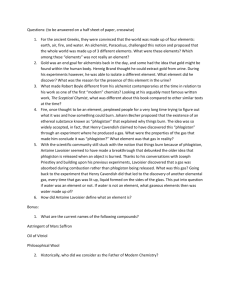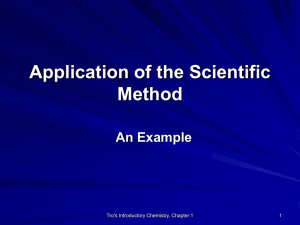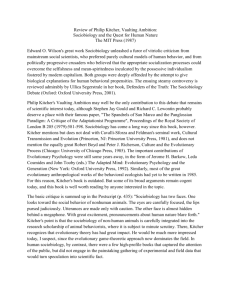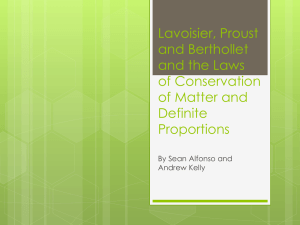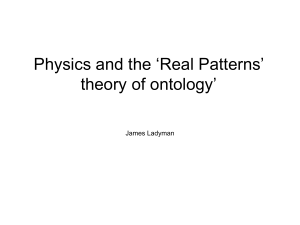The term phlogiston and the notion of" failure to refer"
advertisement
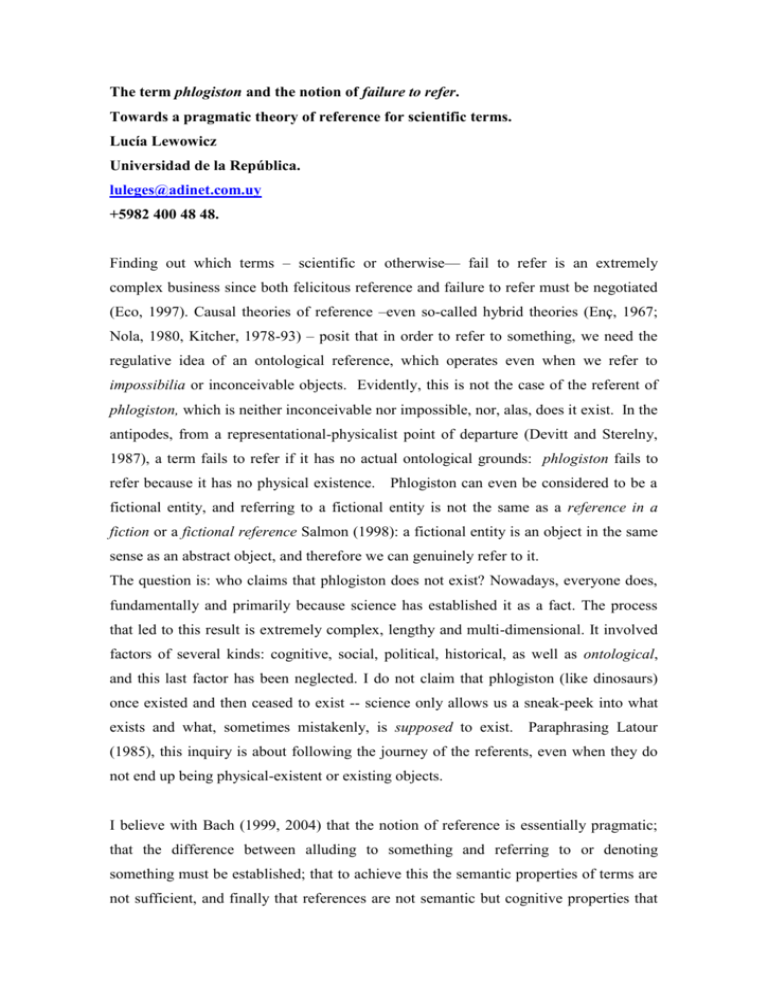
The term phlogiston and the notion of failure to refer. Towards a pragmatic theory of reference for scientific terms. Lucía Lewowicz Universidad de la República. luleges@adinet.com.uy +5982 400 48 48. Finding out which terms – scientific or otherwise— fail to refer is an extremely complex business since both felicitous reference and failure to refer must be negotiated (Eco, 1997). Causal theories of reference –even so-called hybrid theories (Enç, 1967; Nola, 1980, Kitcher, 1978-93) – posit that in order to refer to something, we need the regulative idea of an ontological reference, which operates even when we refer to impossibilia or inconceivable objects. Evidently, this is not the case of the referent of phlogiston, which is neither inconceivable nor impossible, nor, alas, does it exist. In the antipodes, from a representational-physicalist point of departure (Devitt and Sterelny, 1987), a term fails to refer if it has no actual ontological grounds: phlogiston fails to refer because it has no physical existence. Phlogiston can even be considered to be a fictional entity, and referring to a fictional entity is not the same as a reference in a fiction or a fictional reference Salmon (1998): a fictional entity is an object in the same sense as an abstract object, and therefore we can genuinely refer to it. The question is: who claims that phlogiston does not exist? Nowadays, everyone does, fundamentally and primarily because science has established it as a fact. The process that led to this result is extremely complex, lengthy and multi-dimensional. It involved factors of several kinds: cognitive, social, political, historical, as well as ontological, and this last factor has been neglected. I do not claim that phlogiston (like dinosaurs) once existed and then ceased to exist -- science only allows us a sneak-peek into what exists and what, sometimes mistakenly, is supposed to exist. Paraphrasing Latour (1985), this inquiry is about following the journey of the referents, even when they do not end up being physical-existent or existing objects. I believe with Bach (1999, 2004) that the notion of reference is essentially pragmatic; that the difference between alluding to something and referring to or denoting something must be established; that to achieve this the semantic properties of terms are not sufficient, and finally that references are not semantic but cognitive properties that relate thoughts and objects of any kind. My assumption is that to refer to something one must be capable of having thoughts about it and that the propositions one attempts to communicate in the course of referring to it are singular with respect to it. Being in a position to have a thought about a particular thing requires being connected to that thing, via perception, memory, communication and/ or education. Therefore, only in an exceedingly narrow realist theory of reference does phlogiston fail to refer. Unless a theory of reference of scientific terms is based on the study of the actual linguistic communicative practices among scientists, it will inevitably pose serious epistemological difficulties. In the “Introduction” to An Inquiry into Meaning and Truth, Russell (1940) states that he will study some problems related to empirical knowledge; the originality of his text, he claims, lies in the great importance attributed to considerations of a linguistic nature. He adds, laconically, that “whether this result has any value is a question which I shall not consider”. I think Russell’s words provide a partial framework for the way in which scientific language has been studied. However, some questions remain unanswered to this day. Why has scientific language been so important for the philosophy of science of the 20th century? Why is the value of this question not examined? Is the language that interests philosophers of science the same one that scientists are interested in? Or rather, are scientists in the least concerned with “scientific language” that philosophers deal with? An outline of the persistence of the so-called scientific language1 in the development of 20th century philosophy of science will show that: 1) Between 1929 and 1958, the unit of analysis of philosophy of science was the prima facie scientific theory, and specifically the language with which scientific theories were 1 In passim, I would like to refer to Crossland’s (1962/2004) Historical Studies in the Language of Chemistry, a historical study of the language of Chemistry that has absolutely nothing to do with what philosophers usually call “study of scientific language”, without being a philological study or a linguistic study in any of its branches expressed: in a nutshell, all that mattered was the language of theory T and the language of the empirical base O. Authors like Hanson, Feyerabend, Toulmin and particularly Kuhn, attempted to revert that proposal. The amount of interests and concerns increased (the concern about history of science and the scientific community must be underscored here), the challenges changed and something very drastic happened with scientific theories as units of analysis of philosophy of science as well as with their languages. What did not happen, however, was that the latter ceased to be important or that their importance was explained in some way. Kuhn did not question the importance of scientific language but rather turned it into a chamber language of sorts, an élite language whose essence lay in the radical variation of meaning and reference. In other words, the presupposition that if scientific revolutions do exist, they cause some change, for instance in the conceptual structure of theories, and that, if these changes took place, they would inevitably lead to changes in the meaning and reference of scientific terms. It was also suggested that there was a close link between concepts and meaning, with which conceptual relativism became inextricable linked to linguistic relativism. The new vision of science that emerges from this inflexion would eventually bring philosophy of science closer to what science would actually be, according to the Kuhnian dictum, but the discorso on scientific language, albeit widely transformed, is not abandoned while its importance remains unexplained. The new image of science gave place however to a radical change in philosophy of science. Theory “t” is largely abandoned as the unit of analysis of philosophy of science and is substituted by practice “p”. This takes place in the 80s, and at least three movements will take scientific practice as unit of analysis. Today I will focus on Kitcher’s proposal, which posits that one of the most important components of any scientific practice is scientific language. Why is this so? Well, Kitcher, like Russell, remains silent. For Frege, a sign has a sense and a reference: the sense contains the mode of presentation of the reference. Orayen (1973) and Sluga (1980) insisted on the fact that Frege only stated this once and in a single text. Moreover, according to these authors, Frege did not elucidate what he understood by “being contained in”. Consequently, they chose to keep the Fregean notion of sense and leave aside the idea of “mode of presentation of reference”. Causal theorists of reference, on the other hand, paid much attention to this obscure Fregean alternative. Frege also claimed that an expression’s sense determines its reference. I suspect – with Jerrold Katz (2004) that Frege could be wrong here. It is one thing to say that sense helps to identify referents and another to claim that it determines it. The sense of the expression “Eustacia Evergreen”, proposed by Kitcher, even though at first sight it does not have an associated description – it is clearly not a name like Aristotle or James Bond— it allows me to determine that it is a proper feminine name; at the same time, it provides hints to look for a possible bearer of such a name: a female being that could have a proper name – a pet, for instance. It allows me to identify an object but it does not allow me to know whether it is a woman or a cat. In a nutshell, it is not the same thing to identify a referent—if there were one— as to determine it, not to mention fixing it. Based on an extremely complex and unfortunately obscure hybridization between the two canonical theories of reference: the causal and the descriptive theories, Kitcher constructs his theory of reference potentials – at first, in 1978, to account for conceptual continuity and not just radical conceptual change; I insist: conceptual, not referential. Later, in 1993, to account for conceptual progress, which he sees as conceptual – not referential—change. Kitcher characterizes his TRP in such a way that it can be saved qua theory of reference – insofar as we remove it from the context where this author placed it. In the philosophical tradition of science that Kitcher deplores – he calls it “the legend”—matters related to meaning and reference have been dealt with from an exclusively semantic perspective and with a semantics closely associated with logic, that is to say a semantics where truth appears as a purely semantic relationship. However, Kitcher’s TRP will be for him a purely semantic theory, in the same restricted sense of those he criticized. If we observe the set of distinctive features of this theory throughout its many modes of presentation (from 1978 until at least 2000) we see that many of them do not have a purely semantic elucidation, least of all in the restricted sense used by Kitcher himself. These features are: 1) An interesting theory of reference must be context-sensitive 2) Kitcher’s context has an exclusively pragmatic elucidation: it is the post-festum context, the one that can be attributed to the recipient, in this case, the historian or philosopher of science. It is not the context of the speaker. 3) We must study utterances, not sentences. 4) Scientists have certain intentions when producing these utterances. Kitcher specifies these intentions as follows: a. The intention to refer to natural kinds – or, as Kitcher calls it, the naturalist intention b. Scientists have the intention to be understood. c. The intention to conform to the way their community understands such concepts (conformist intention). 5) Intentions are determined with the help of a device created by Richard Grandy and called “Principle of Humanity” , which claims that we must impose on the scientist we are studying “a pattern of relations among beliefs, desires and the world which is as similar to ours as possible” (Grandy 1973:443) 6) Scientists’ utterances contain token-expressions (not type-expressions). What must be determined then is what these tokens refer to, not what the types refer to. 7) The referents of these instances – were they to exist—are those entities that appear appropriately in the correct historical explanation of the production of said token. A historical explanation is for Kitcher a sequence of events or modes of reference. In none of the presentations of the theories of reference potentials does Kitcher manage to explain what he means by “figure appropriately” Neither does he manage to elucidate when we would obtain a “historically correct explanation”. a) The causal mode of reference or event (it is neither an act nor a relation). This is the only element, stricto sensu, that Kitcher takes from the classical causal theory of reference. The compendium of modes of reference are not always baptismal. On the contrary, a sequence of events or a set of events is not the same as a causal chain: in a causal chain it can be perceived at first sight what type of function unites baptismal acts; when one refers to a sequence of events one is presupposing a function that links the elements of the succession. Kitcher, however, does never determine what that function is. Nevertheless, on several occasions Kitcher associates his own theory with the classical causal theory, and moreover he attempts to refine it. He also associates his own theory with the descriptive-causal theory of Devitt and Sterelny, with which it does have a strong family resemblance. b) The mode of reference or descriptive event. Apart from its somewhat baroque notion of “sense” the descriptive mode of reference is taken from the classical descriptive theories of reference. I call it “baroque” because Kitcher considers Fregean sense to be a mysterious intensional entity, but even though he rejects this notion, he seems to keep that which is contained in the sense: namely, the mode of presentation of the reference, that is to say, he keeps an extensional entity (à la Devitt and Sterelny) which is also mysterious. I am not talking about some descriptive component that plays a part in baptismal act: this is another way of fixing reference. And finally, c) The mode of reference or event by conformity which is Kitcher’s own, but which collapses in one or the other previous modes of reference. 5) Reference potentials (or compendia of modes of references) can be homogeneous or heterogeneous. Conceptual change and conceptual progress are only related to the latter and heterogeneity is due to the accumulation of heterogeneous modes of reference, that is to say, causal, descriptive or by conformity. Conceptual progress should consist in the elimination of heterogeneity if this was a theory of referential uniformity – but Kitcher remains silent on this topic. Kitcher’s example of “dephlogisticized air” and “oxygen” is a poor illustration of this issue. The idea, in a nutshell is this: Priestley isolates an “air”, one of whose properties is to facilitate combustion, and he calls it “dephlogisticized air”. For Lavoisier, oxygen also has this property. Therefore, for Kitcher, “dephlogisticized air” belongs to the reference potential of oxygen and viceversa. Curiously, the counterexample of the theory of reference potentials is, precisely, phlogiston: if we applied TRP it should follow that, until the mid-19th century, phlogiston does not fail to refer. In other words, there existed a mode of reference, a mode of fixing reference by primeval description “matter of fire, heat or light”, which did not fail to refer. These are the main features of the theory of reference potentials. Therefore, 1. TRP is not a theory of referential continuity; it is not even a theory of reference. 2. To consider TRP as a theory of reference, we must relocate it, pace Kitcher, within the pragmatics of language. 3. Considering TRP within pragmatics would allow us to see how conceptual change takes place in scientific practice. The process of scientific communication during the practical exercise of the science in question would facilitate the refinement and stabilization of the references of scientific concepts. 4. The reference of scientific concepts is more a cognitive than a semantic question. To ensure the referential stability of a scientific term is an arduous scientific work, as the historic case of phlogiston shows. As is widely known, the history of the concept of phlogiston is the history of an abandoned scientific concept. To put it in Kitcher’s terms, it is the history of a concept that has lost its reference potentials. For Lavoisier, phlogiston was a wild-card of sorts: it provided all kinds of explanations and it could be anything; he called it Proteus. Lavoisier’s misgivings against phlogiston were fundamentally logical and linguistic, but they were also conceptual. Fairly recent developments in Physics showed that a substance could not have negative weight. But was phlogiston actually a substance for Lavoisier? Surprisingly, it was. Phlogiston was the matter (in the strong sense of the word) of heat, fire and/or light. In other words, phlogiston was that which is almost always emitted in combustion. Since phlogiston carried an enormous amount of heterogeneous reference potentials, Lavoisier decided to keep the primeval referent of phlogiston and re-baptize it: he called it caloric, at the time an expression that was free of reference potentials. The referent of phlogiston continued to exist in pneumatic and modern Chemistry until the mid-20th century, when thermodynamics changed the way in which heat was conceived, and it was no longer considered a material substance. Lavoisier made phlogiston failed to refer. He simply destroyed every mode of reference of phlogiston except one, its primeval referent: Stahl’s definition: matter of fire, heat and/or light, and he associated the new word “caloric” to this referent. Lavoisier could not leave out of his theory of combustion a perceptual phenomenon: almost every combustion emits either light, or heat, or flame, or smoke. To conclude, TRP involves 1. The difference between token and type 2. The difference between utterances and sentences 3. The difference between meaning and use 4. The difference between linguistic meaning and speaker-meaning 5. Context-sensibility. What does it lack, then to be considered a pragmatic theory of reference? 6. The communicative intention 7. The context of the audience – in our case, the scientists’ contemporaries and afterwards the historians and philosophers of science. There is, however, another group of realist philosophers interested in the material world, and what it can produce, how it influences and alters our ways of knowing, in the role played by other objects – which we alter or even construct--, in the emergence of ontological and not merely conceptual novelties, in a social reality that logically precedes us and is independent from us and which also acts upon us. Moreover, this kind of realism has attempted to unveil the reasons for this mysterious situation: why is the world so tractable to our cognitive systems? In order to answer this question, it is necessary to: 1) Observe the possibilities of conceiving an epistemic-pragmatic theory of reference for scientific terms for which our cognitive capacity is what determines the references of concepts and terms. The semantic relation is, in any case, a consequence of this and not a point of departure. 2) Attempt to conceive a theory of reference that foregrounds the role played by the objects of study of science. This is part of what Latour’s theory of circulating reference achieves. 3) Defend the idea that the study of the referents of scientific terms brings us much closer to the history of scientific practice. And, methodologically, they are more helpful than the references or meanings of scientific terms: science attempts to refer to its referents, it attempts to know the real world; being able to eliminate referents, proving their inexistence, also constitutes scientific progress.
